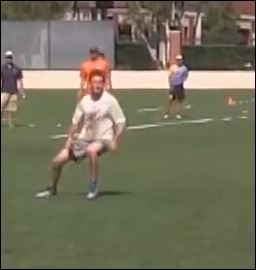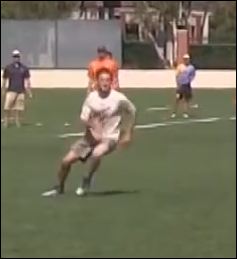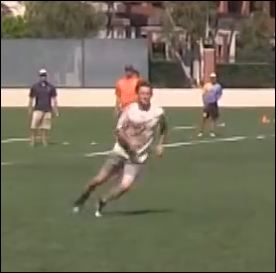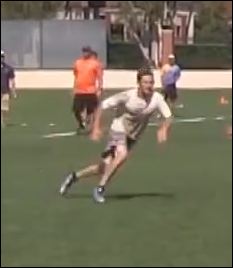I’ve been thinking a bit about how to teach players to poach lately and got excited when I noticed a heads-up poach block by Eli Kerns after reviewing some footage. I wanted to highlight this specific play because it is one of the easiest ways that a player new to poaching can generate more blocks off of a horizontal stack.
Context: this is the 2014 Southwest Regionals Game-to-Go between UC Davis and UC San Diego. UC San Diego goes up early, and at this point in the game, the Davis D-line hasn’t been able to force too many mistakes. Realizing this, Eli starts looking to generate active blocks by opportunistically poaching off the horizontal stack.
Watch the following progression (17:08 in the footage) in slow motion. You can use the left and right arrows on the GFY to go frame-by frame:
[gfycat data_id=”PolishedVeneratedArgentineruddyduck” data_title=”false”]
- Kerns (in white, on the left side of the screen) trails his defender, who is making a cut to the force sideline.
- Seeing Kerns trailing closely, the UCSD handler, #44, looks off his cutter and immediately shifts his eyes, head, and pivot towards the middle cutter in the horizontal stack.
- Kerns notices the change in positioning and stops in the lane between the defender and the disc. Because he can see #44s head already focusing on the next cutter, he knows #44 isn’t looking at him and he can bait the block.
- As soon as #44 releases, Kerns plants, performs a beautiful crossover step that would make Tim Morrill proud, and speeds in front of the oncoming cutter for a spectacular catch block.
Newer players who are not yet comfortable with defensive poaching can learn a lot from this specific situation.
Want to get more poach blocks? Start with the following:
1. Look to poach the lane after defending an under cut
If the cutter you’re defending is looked off coming under, the easiest way to slow down an opposing team’s offense is to hang in the lane for a few seconds while the cutter clears back into the stack. Even if you don’t manage to get a block, the extra few seconds in the lane muck up the opposing offense and can set up additional opportunities to force the turnover.
2. Use tells to predict a thrower’s next decision
Throwers, especially newer throwers, have multiple tells that can help predict what their next option is. Common tells include:
- Changing pivot, stance, or grip
- Pump faking to get a cutter to change direction
- Turning eyes and head towards the next throwing target
Individual players also have their own unique tells that can help you gain a few dozen milliseconds of advantage when defending their throws. These become more evident by studying tape or scouting opponents which you match up against often. For example, a number of players have a hitch in their forehands. These players often “cock” their forehand like they would a pistol before releasing in order to generate more power. This extra half-second can be the difference between staying in the lane and diving in for a block. Other players look backwards or to the side as they wind up for a backhand huck, making them blind to poachers coming from their forehand side. Ben Wiggins reported in his reddit AMA that he was able to get a block on Jolian Dahl in the 2007 Nationals Final after studying footage of him doing this.
Think about the throwers you play against often. What tells do they have and how can you best exploit them?
3. Work on your change of direction
As aware as Eli is, he wouldn’t have generated the block he did without a fantastic plant and crossover step. Take a look at his crossover progression:




For a pristine change of direction, practice sport-specific footwork and increase your strength, which determines how much force you’re able to put into the ground. For more, check out Tim Morrill teaching the crossover step.
Thanks to Ultiworld for the footage.









Comments Policy: At Skyd, we value all legitimate contributions to the discussion of ultimate. However, please ensure your input is respectful. Hateful, slanderous, or disrespectful comments will be deleted. For grammatical, factual, and typographic errors, instead of leaving a comment, please e-mail our editors directly at editors [at] skydmagazine.com.